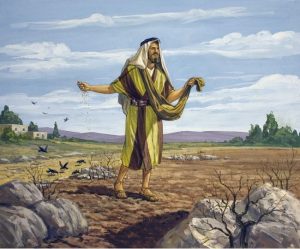Ever wonder why Jesus spoke in parables, more than any of the disciples or even the prophets? What was it about this form of communication that caused it to be used throughout the Bible? Why did Jesus spend time telling stories, instead of just telling us straight out what we need to know?
Whether it was similes, metaphors, allegories, or parables, they all had a place in Jesus’ creative style of preaching; and as His disciples, we should master this form of spreading the gospel. A good sermon illustration stays with its listeners far longer than we realize.
How many of you remember what H.M.S. Richards, Sr., the founder of Voice of Prophecy, said when asked about whether women should use cosmetics? He is reported to have said, “If the barn needs painting, paint it.” He was not just getting himself out of a ticklish question. Perhaps he knew that it was Jesus’ style to make people think and give them something they would remember.
Memory Text: “Jesus spoke all these things to the crowd in parables; he did not say anything to them without using a parable. So was fulfilled what was spoken through the prophet: ‘I will open my mouth in parables, I will utter things hidden since the creation of the world.'” Matthew 13:34-35 NIV [cross-reference to Psalm 78:2]
Intellect alone can not suffice in expressing our salvation. We humans crave stories and concrete illustrations from everyday life that touch our emotions as well.
Sunday: Old Testament Examples
The first parable in the Old Testament that comes to mind is often the story that Nathan told King David for the purpose of showing him his sin with Bathsheba. Read about it in II Samuel 12:1-7. The story of the rich man who killed the only lamb of a poor man in order to feed his guests made David instantly indignant that such an unfair practice had happened in his kingdom.
After announcing the harshest sentence of death for the king, and requiring him first to pay fourfold for the lamb, Nathan reveals that David is the rich man in the story. This resulted in the most heartfelt prayer of repentance by David, preserved for us in Psalm 51.
Other prophets in the Old Testament, such as Isaiah, Jeremiah, and Ezekiel, shared language rich in symbols and metaphors. They spoke of farmers sowing, threshing, wineskins, vines, and fire, in order to explain the difficult-to-understand themes of the consequences of sin and what God’s salvation can mean for us.
Discussion Question: Jesus and the Old Testament prophets used many of the same analogies as teaching tools for the people. Was this evidence of Jesus’ borrowing from their works, or do we see it as confirming that Jesus was the true author of the Hebrew Scriptures?
What made these symbols and metaphors so powerful?
Monday: Architectural Wisdom
Two of Jesus’ most familiar parables are about buildings and they are definite statements about discipleship. One in Matthew 7:24-27 speaks of a wise man building his house on a rock and a foolish man building it on the sand. In many cases of oral storytelling, the lesson comes at the end of the story.
But as you read this parable, it’s important not to miss the beginning statement. Jesus is upfront with information that this story of the wise man is about someone who not only hears His words, but does them. And the opposite is true about the foolish man.
The message is clear: in order to be Jesus’ disciples, one must be like the wise man and not only hear, but do His commandments.
The other parables about building a tower and about a king going into battle, found in Luke 14:27-33, also enlighten us about the cost of discipleship. It says:
“And whosoever doth not bear his cross, and come after me, cannot be my disciple.” Luke 14:27 KJV
He goes on to say that if you build something, you want to ensure that you will have all the materials to complete your project, and therefore you make careful plans and count the cost. The same for the king. How tragic if he doesn’t have well-laid plans when he takes his country to war.
Instead of overwhelming them with a list of the costs of their discipleship, such as self-sacrifice, mental and physical suffering, rejection, humiliation, and possibly even death, He simply encourages them to count the cost and prepare for these things before they happen. How important it would be for them to do this to prevent them from bailing out when things got tough.
Discussion Questions: Often when we teach children stories and songs from and about the Bible, such as the song “The Wise Man Built His House Upon the Rock”, we avoid going into deep discussions about the meaning of the stories and illustrations. Is there any value for them to know and recite the words, when they aren’t yet capable of understanding their full meaning?
Why are children’s stories included in the worship service in most churches? What can adults gain from hearing the stories meant for the kids? Why is the children’s story often the only part of the sermon we can remember?
Tuesday: Agricultural Analogies
Besides building things, growing things is a common metaphor in the Bible. Jesus uses symbols from agriculture, such as the parable of the sower found in Matthew 13:1-30.
Although this parable was told to a large multitude, its appeal increases when He later explains the meaning of the parable to His questioning disciples (starting with v. 18). He explains how the ground represents how people receive His word, when planted by the sower.
- Seed planted by the wayside: the devil comes along and snatches it up
- Seed planted on stony places: tribulation and trials prevent it from taking root
- Seed planted among thorns: worldly concerns and cares cause it to be unfruitful
- Seed planted on good ground: hears the word, understands it, and becomes fruitful
The quality of a story rests on its applications and how it can engage us on more than one level. For instance, we can identify ourselves with the farmer and become aware of the soil, or spiritual condition, of our hearers. This was perhaps the application the disciples first considered. They thought of themselves as the sower.
Upon further reflection, however, the soil as the condition of the heart would cause them to think about their own heart soils. How important for us all to make sure we not let the cares of this world, including “the deceitfulness of riches” (v. 22), choke out God’s message for us.
Discussion Questions: How can riches deceive us?
If Jesus’ parables were easy for the people to understand, why did He often have to explain them to the disciples?
Why is it important to “know your audience”?
Wednesday: The Revolutionary’s War
In the fight against evil, Jesus and His prophets found expression through parables and symbols, weapons that cut through hearts and minds without endangering their future work and influence with the people. We often notice that many of Jesus’ parables were aimed at the religious leaders, but were so disguised and yet so pointed, that it was obvious who were implicated and to deny it was impossible.
This was exactly the case with His parable of the two sons (Matthew 21:28-32). One son said he wouldn’t go to work in his father’s vineyard, but later felt bad and did go. The other son said he would go, but did not. The chief priests and elders could not deny that it was the first son who did the will of his father. Jesus didn’t hesitate to remind them that publicans and harlots were better candidates for the Kingdom than they were (v. 31-32).
Jesus also blasted, in a friendly way, the religious leaders in His parable of the great banquet in Luke 14:16-24. When no one accepted the invitation to the banquet feast, the host ordered his servants to invite people on the street to come. Then again His parable of the tenants, in Luke 20:9-19, who beat up those who were sent to them from their landlord and finally killed his own son when he was sent, must have struck a chord with its hearers.
We think of the hearts of the leaders being hardened by these stories, but there were undoubtedly some of the ruling classes whose hearts were softened by His reprimands. It reminds us, by the power and guidance of the Holy Spirit, to sow the seed in love no matter what soil it falls on.
Discussion Questions: How can these parables, aimed at the church leaders of Jesus’ day, be applied to the church today?
“The parable of the vineyard applies not alone to the Jewish nation. It has a lesson for us. The church in this generation has been endowed by God with great privileges and blessings, and He expects corresponding returns.” ~Ellen G. White, Christ’s Object Lessons, p. 296.
How can we further apply the parables’ lessons to our individual lives? In what ways do they impact our discipleship with Jesus?
Why did Jesus leave so many of His parables open-ended, such as the Prodigal Son? How do you think that story ended?
Thursday: Christ’s Creative Legacy
Here’s how other disciples and followers of Christ utilized concrete examples to illustrate Bible truth:
- Peter’s vision of the blanket coming down with animals (Acts 10:9-16)
- Paul comparison of our body to a house or temple (I Corinthians 3:10-15), and marriage to our relationship with God (Romans 7:1-6)
- James’ description of the tongue as a bit in the mouth of a horse–or the rudder of a ship–fire–like trying to tame a wild animal–or as poison (James 3:3-12)
- John the Revelator using symbols, such as warfare with a dragon, a lament over Babylon, and the rider on a white horse (Revelation 12:7-17; 18:9-20; 19:11-16)
As we can see, stories and illustrations are not just “fillers” or “fluff” in a sermon. They can be the main vehicle for communicating the message, and we should not hesitate to use them.
Discussion Questions: What sermon illustrations are helpful in our world today? What topics and stories grab attention and help people understand salvation better? [suggestions: cell phones, computers, fitness gyms, sports]
Summary: Here’s some reasons why parables or stories are useful for God’s disciples through the ages:
- They reach people where they are.
- They help us grasp difficult concepts.
- They are easy to remember and repeat to others.
- They grab our emotions and encourage us to action.
- They allow sensitive subjects to be discussed in a non-confrontational manner.
Challenge for the Week: Review the parable of the sower in Matthew 13:1-30. Then examine the condition of your own heart and make changes to improve your soil to receive the Word. Also make sure you plant some seeds of truth in someone else’s heart this week, keeping in mind that the most powerful story you have to share is your own.
Next Week: Discipleship and Prayer









